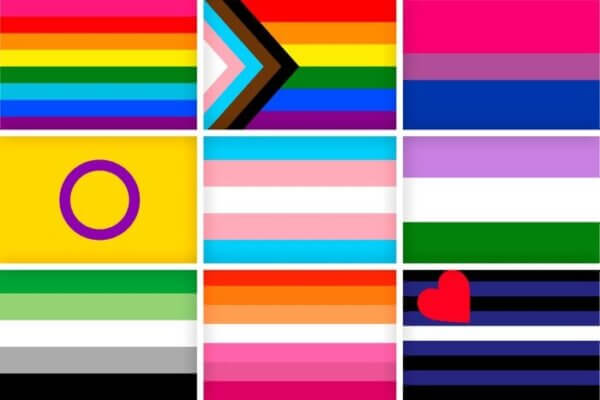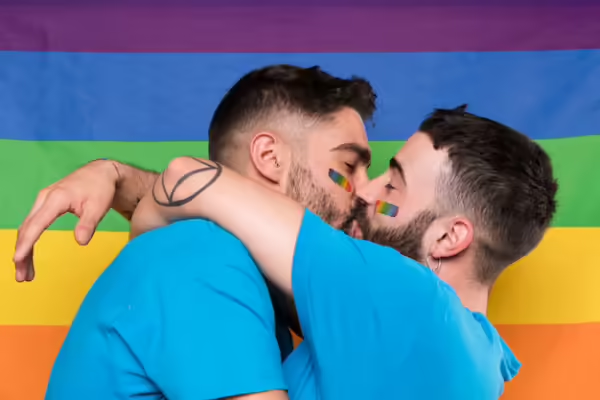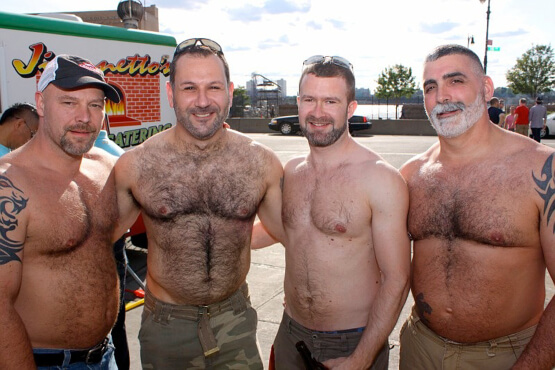There is no single rainbow flag but so many subcategories related to each type of sexual orientation.
Flags are more than just colorful pieces of cloth; they are powerful symbols that represent identity, community, and struggles for equality. For the LGBTQ+ community, flags are a beacon of pride, a sign of belonging, and a cry of resistance. In this article, we will discuss the history and significance of each LGBTQ+ flag.
Guidance on all LGBTQ+ flags
In this guide, we will explore the fascinating world of LGBTQ+ flags, from the best known like the rainbow flag, to those representing specific identities and subcultures.
We will learn about the history, meaning and importance of each flag, and how they have evolved over time to reflect the diversity and richness of the LGBTQ+ community.
Whether you are a community member, an ally , or simply curious to learn more, this guide will give you a comprehensive and engaging overview of the flags that represent LGBTQ+ pride around the world.
Original Rainbow Flag by Gilbert Baker
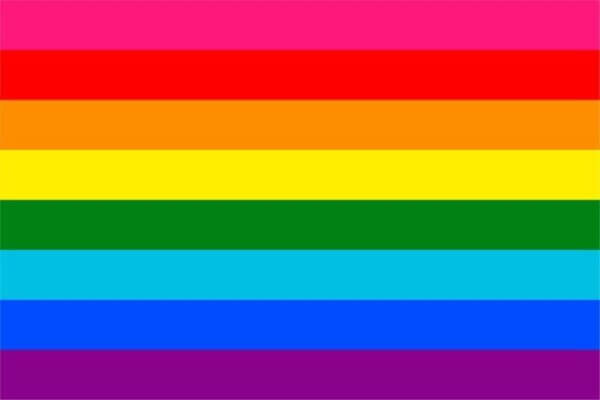
The Gilbert Baker Pride Flag, also known as the original rainbow flag, was created in 1978 by artist and activist Gilbert Baker. This flag, consisting of eight stripes of color, was designed as a symbol of hope and liberation for the LGBTQ+ community.
Meaning of colors:
Each color of the original flag had a specific meaning:
- Shocking Pink: Sexuality
- Red: Life
- Orange: Healing
- Yellow: Sunlight
- Green: Nature
- Turquoise: Magic/Art
- Indigo: Serenity/Harmony
- Viola: Spirit
Evolution of the flag:
The original eight-striped flag has undergone some changes over the years. The shocking pink and turquoise were removed due to production problems, leading to the six-striped version we know today (red, orange, yellow, green, blue, purple).
In 2017, Baker proposed a nine-strip version, adding lavender at the top to represent diversity.
The Gilbert Baker Pride Flag has become an iconic symbol of LGBTQ+ pride around the world. It has been flown at rallies, parades, and events, becoming a powerful symbol of visibility and acceptance.
Gilbert Baker was a pioneer in the fight for LGBTQ+ rights, and his flag has become an enduring symbol of his commitment. The rainbow flag continues to inspire and unite the LGBTQ+ community, reminding us of the importance of diversity, equality, and pride.
Original LGBTQ+ Flag
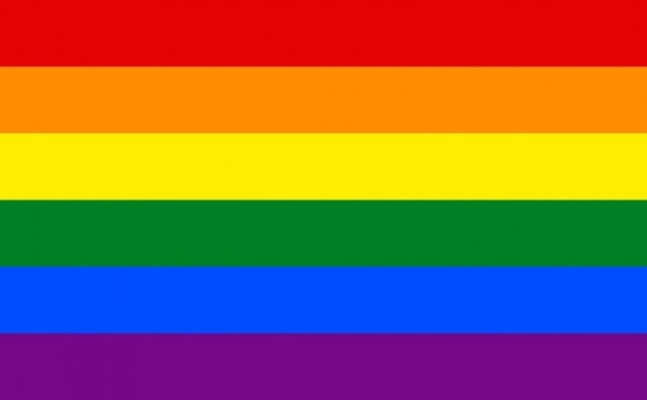
The 1978 Pride Flag, also known as the original rainbow flag, was created by artist and activist Gilbert Baker at the request of Harvey Milk, the first openly gay politician elected in the United States. This flag was conceived as a symbol of hope and liberation for the LGBTQ+ community, and was first unveiled on June 25, 1978 at Gay Pride in San Francisco.
The eight-striped flag, however, was short-lived. Due to production problems and fabric availability, the shocking pink and turquoise were removed, leading to the six-striped version we know today: red, orange, yellow, green, blue, and purple.
Despite its short existence, the 1978 Pride Flag had a lasting impact. It laid the foundation for the iconic six-striped rainbow flag, becoming a universal symbol of LGBTQ+ pride and a powerful tool for visibility and acceptance.
Flag Pride people of color
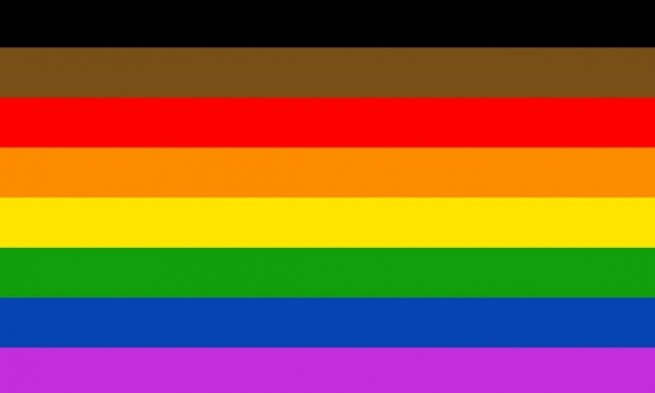
The“More Color, More Pride Flag” or “Philadelphia Flag” is a reimagining of the traditional rainbow flag, created in 2017 to promote greater inclusiveness within the LGBTQ+ community.
This flag adds two black and brown stripes on top of the original six rainbow stripes. The black and brown stripes represent people of color and marginalized communities within the LGBTQ+ community, recognizing their specific struggles and the need for greater inclusion.
The flag was officially adopted by the city of Philadelphia in 2017, becoming a powerful symbol of solidarity and commitment to racial equity within the LGBTQ+ movement.
The “More Color, More Pride Flag” has sparked debate and discussion within the community, with some seeing it as an important step toward greater inclusiveness and others seeing it as an unnecessary change to the original symbol.
Despite differing opinions, the “More Color, More Pride” flag has gained popularity in different parts of the world, becoming a visible symbol of the commitment to inclusion and racial justice within the LGBTQ+ community.
Progress Flag
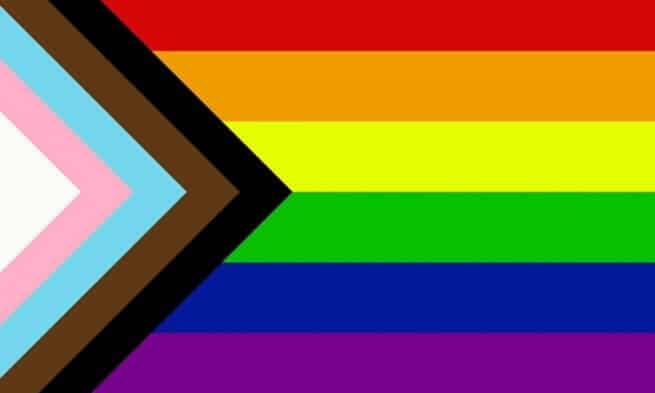
The Progress Pride Flag, also known as the Flag of Progress, is a reimagining of the traditional rainbow flag, created in 2018 by designer Daniel Quasar. This flag aims to represent greater inclusivity within the LGBTQ+ community by recognizing the specific struggles of people of color and transgender people.
Flag features:
The Progress Pride Flag retains the six horizontal stripes of the original rainbow flag, but adds a triangle on the left consisting of five stripes:
- Black and brown: Represent people of color and marginalized communities within the LGBTQ+ community.
- Pink, blue and white: Represent transgender people and the trans community.
The triangle is placed to the left to indicate that progress toward equality is still in progress and that there is still much work to be done.
Meaning of the flag:
The Progress Pride Flag is a powerful symbol of inclusion and solidarity. It recognizes that the struggle for LGBTQ+ rights is intersectional and that people of color and transgender people face unique challenges. The flag aims to create a sense of belonging for all members of the LGBTQ+ community, regardless of their race, gender, or identity.
Bisexual pride flag
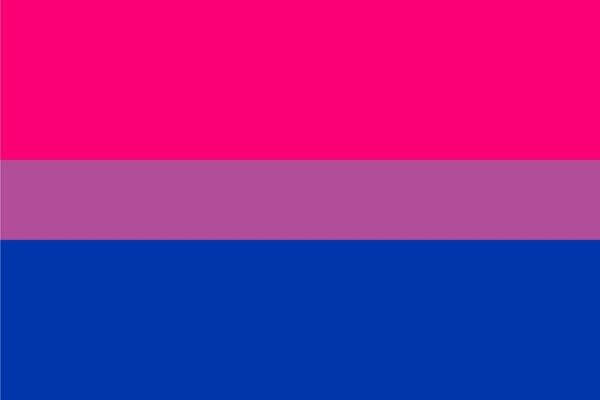
The Bisexual Pride Flag, or bisexual pride flag, was created in 1998 by Michael Page to give greater visibility and representation to the bisexual community.
Flag features:
The flag consists of three horizontal stripes of color:
- Shocking pink (Pantone 226): Represents same-sex attraction.
- Purple (Pantone 258): Represents attraction to both sexes, or the very essence of bisexuality.
- Royal blue (Pantone 286): Represents attraction to the opposite sex.
The proportion of stripes is 40% pink, 20% purple and 40% blue.
Meaning of the flag:
The colors and proportions of the flag have a definite meaning:
- Pink and blue, with their equal size, symbolize the importance and validity of both same-sex and opposite-sex attraction within the bisexual experience.
- Purple, in the center and smaller in size, represents the fusion and interconnection between these two attractions, creating a unique and distinct identity.
Impact and diffusion:
The Bisexual Pride Flag has become an important symbol for the bisexual community, offering a sense of belonging and visibility. It is used at rallies, Pride parades, and other events to celebrate bisexual pride.
Symbolism:
The bisexual flag is more than just a symbol. It represents the struggle for recognition and acceptance of bisexuality, which is often misunderstood and invisibilized. The flag challenges stereotypes and discrimination, affirming that attraction to more than one gender is valid and real.
The Bisexual Pride Flag is an ever-evolving symbol that reflects the diversity and complexity of the bisexual experience. It continues to inspire and unite the bisexual community, promoting visibility, pride and acceptance.
Pansexual pride flag
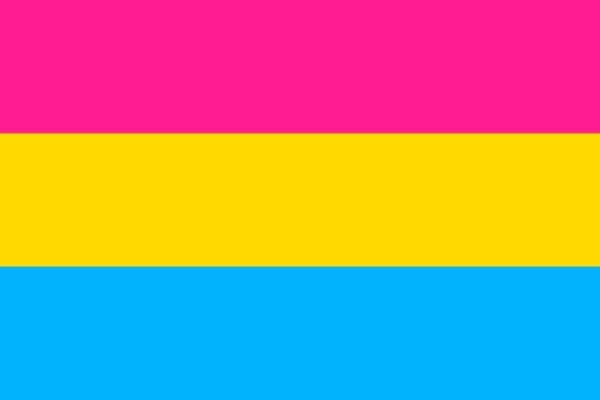
The Pansexual Pride Flag, or pansexual pride flag, is a symbol of identity and visibility for the pansexual community. It was created in 2010 and has gained popularity in the years since.
Flag features:
The flag consists of three horizontal stripes of equal size:
- Pink: Represents attraction to women (regardless of gender identity).
- Yellow: Represents attraction to nonbinary or gender-fluid people.
- Blue: Represents attraction to men (regardless of gender identity).
Meaning of the flag:
The Pansexual Pride Flag represents attraction to people of all genders, regardless of their biological sex or gender identity. The term “pansexual” comes from the Greek word “pan,” meaning “all,” and emphasizes the inclusiveness of this identity. The flag symbolizes the ability to love and appreciate people for who they are, beyond gender labels.
Difference with the bisexual flag:
The Pansexual Pride Flag differs from the Bisexual Pride Flag in the inclusion of the yellow stripe, which represents attraction to non-binary people. This difference reflects a different understanding of attraction, with pansexuality embracing a wider range of gender identities than bisexuality, which traditionally referred to attraction to both sexes.
The Pansexual Pride Flag has helped raise the profile of the pansexual community by providing a symbol of identification and pride. It has been used in rallies, Pride parades and other events to celebrate pansexual identity and promote acceptance.
Symbolism:
The pansexual flag represents the struggle for the recognition and acceptance of pansexuality, which is often misunderstood or confused with other identities. The flag challenges stereotypes and discrimination, affirming that attraction to people of all genders is valid and real.
Asexual flag
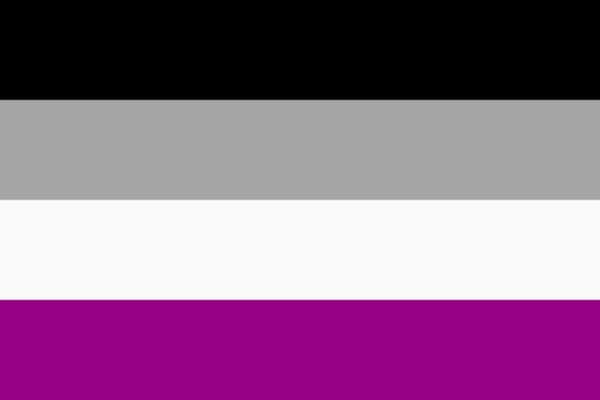
The Asexual Pride Flag, or asexual pride flag, is a symbol of identity and visibility for the asexual community. It was created in 2010 following an online contest organized by the Asexual Visibility and Education Network (AVEN).
Flag features:
The flag consists of four horizontal stripes of color:
- Black: Represents asexuality in general, the absence of sexual attraction.
- Gray: Represents the gray area of asexuality, that is, people who identify as demisexual (who experience sexual attraction only after developing a strong emotional bond) or grey-A (who experience sexual attraction rarely or with low intensity).
- White: Represents allies and nonsexual partners.
- Purple: Represents the asexual community and sense of belonging.
Meaning of the flag:
The Asexual Pride Flag represents the full range of the asexual experience, from the complete absence of sexual attraction to the various shades of the gray zone. The flag symbolizes pride in being asexual and the validity of this identity, which is often misunderstood or invisibilized.
Impact and diffusion:
The Asexual Pride Flag has helped raise the profile of the asexual community by providing a symbol of identification and pride. It is used in rallies, Pride parades and other events to celebrate asexual identity and promote acceptance.
Symbolism:
The asexual flag represents the struggle for recognition and acceptance of asexuality, which is often stigmatized or denied. The flag challenges stereotypes about sexuality, affirming that the absence of sexual attraction is a valid human experience and that asexual people deserve respect and inclusion.
Lesbian feminist flag
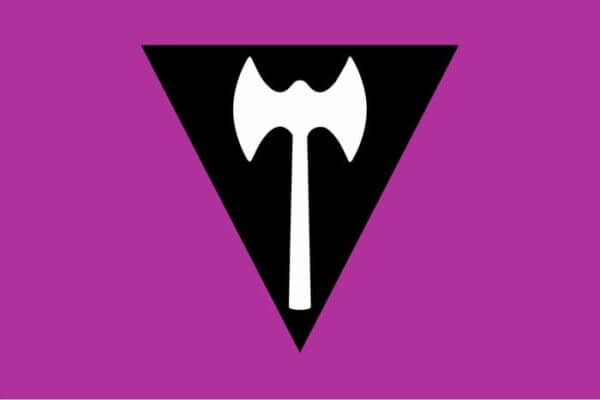
The Labrys Lesbian Pride Flag is a symbol of pride and identity for the lesbian community, particularly feminist lesbians. Created in 1999 by graphic designer Sean Campbell, this flag is a powerful reminder of lesbian history and culture.
Flag features:
The Labrys Lesbian Pride Flag features:
- Purple background: Purple is a color historically associated with lesbians, thanks to the poetess Sappho, who often used images of purple flowers in her works.
- Inverted black triangle: This symbol represents the persecution of lesbians during the Holocaust, when they were branded with inverted black triangles as a sign of “antisociality.”
- Labrys: A double-bladed axe used by the Amazons, a mythological people of women warriors. The labrys became a symbol of female strength and autonomy, adopted by lesbian feminists in the 1970s.
Meaning of the flag:
The Labrys Lesbian Pride Flag represents the strength, resilience and resistance of the lesbian community. The labrys symbolizes female empowerment and the struggle against patriarchal oppression. The inverted black triangle recalls the history of persecution and discrimination suffered by lesbians, while the purple background celebrates lesbian culture and identity.
Impact and diffusion:
The Labrys Lesbian Pride Flag has been adopted by many lesbians as a symbol of pride and belonging. It is often displayed at events, Pride parades and other LGBTQ+ events to represent the lesbian community and its history.
Disputes:
The Labrys Lesbian Pride Flag has stirred some controversy because of its association with lesbian separatism and radical feminism, movements that some consider exclusive or trans-exclusive. However, many lesbians continue to use this flag as a symbol of pride and identity, regardless of their political views.
Intersex Flag
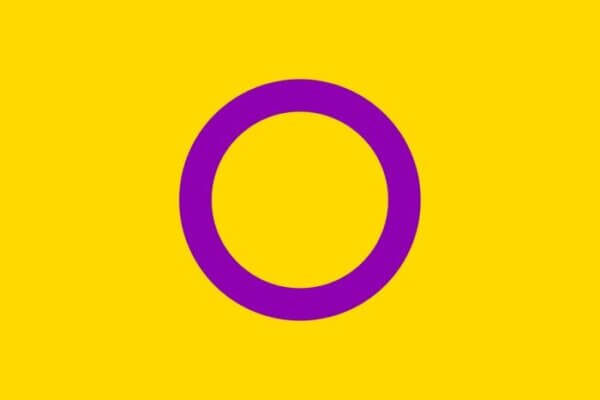
The Intersex Pride Flag, or Intersex Pride Flag, is a symbol of identity and visibility for the intersex community, that is, people born with sexual characteristics that do not fit the typical definitions of male or female.
Flag features:
The flag, created by Morgan Carpenter of Intersex Human Rights Australia in 2013, features:
- Yellow background: Yellow was chosen because it is a color often associated with intersexuality in nature (e.g., some snails are hermaphroditic and have yellow hues).
- Purple circle: The circle represents the integrity and wholeness of intersex people, challenging the notion that they must conform to a binary gender norm. Purple, not found in the rainbow, was chosen because of its historical association with gender ambiguity.
Meaning of the flag:
The Intersex Pride Flag represents the pride of being intersex and the struggle for the human rights of intersex people. The flag symbolizes the demand for bodily autonomy and the right to live a life free from discrimination and unnecessary medical interventions.
The Intersex Pride Flag has become an important symbol for the intersex community, offering a sense of belonging and visibility. It is used in rallies, Pride parades and other events to celebrate intersex identity and promote human rights.
Symbolism:
The intersex flag represents the struggle for recognition and acceptance of intersexuality, which is often stigmatized or pathologized by society. The flag challenges the binary view of gender and sexuality, affirming that biological diversity is natural and that intersex people deserve respect and dignity.
Transgender Flag
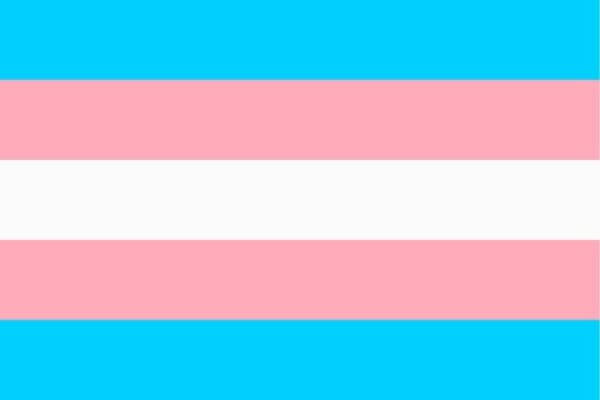
The Transgender Pride Flag is a symbol of pride and identity for the transgender community. Designed in 1999 by transgender American woman Monica Helms, it was first displayed at a Pride parade in Phoenix, Arizona, in 2000.
Flag features:
The flag consists of five horizontal stripes:
- Light blue: Color traditionally associated with male infants.
- Light pink: Color traditionally associated with female newborns.
- White: Represents people who are identifying as transgender, those who feel they are gender neutral, no gender or those who are intersex.
The color sequence is symmetrical so that the flag has the same meaning whether it is flown with one side up or the other side up.
Meaning of the flag:
Monica Helms describes the meaning of the transgender flag as follows:
- “The stripes at the top and bottom are light blue, the traditional color for boy children. The stripes next to it are pink, the traditional color for girls. The stripe in the middle is white, for those who are transitioning or consider themselves gender neutral or genderless.”
The Transgender Pride Flag has become a widely recognized symbol of the transgender community worldwide. It is displayed at events, Pride parades, and rallies to promote the visibility and acceptance of transgender people.
Symbolism:
The flag represents transgender pride and the diversity of gender identities. It is a symbol of resistance against transphobia and discrimination, and a reminder that transgender people deserve respect and equality.
Genderfluid Pride Flag
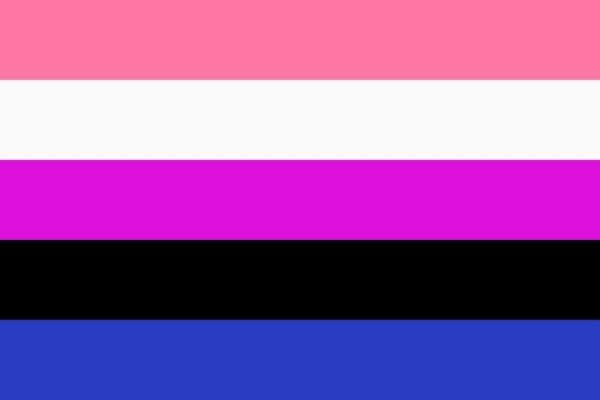
a Genderfluid Pride Flag, or genderfluid pride flag, is a symbol of identity and visibility for genderfluid people, that is, those whose gender identity is not fixed, but fluctuates over time between different gender expressions.
Flag features:
The flag, created by JJ Poole in 2012, consists of five horizontal stripes:
- Pink: It represents femininity.
- White: Represents genderlessness.
- Purple: Represents the combination of femininity and masculinity.
- Black: Represents all genres.
- Blue: Represents masculinity.
Meaning of the flag:
The Genderfluid Pride Flag represents the fluidity and dynamism of gender identity. The colors and their arrangement symbolize movement between different expressions of gender, genderlessness, and the inclusion of all genders.
The Genderfluid Pride Flag has helped raise the profile of the genderfluid community by providing a symbol of identification and pride. It is used at rallies, Pride parades, and other events to celebrate genderfluid identity and promote acceptance.
Symbolism:
The genderfluid flag represents the struggle for the recognition and acceptance of gender fluidity, which is often misunderstood or invalidated. The flag challenges the binary view of gender, affirming that gender identity can be fluid and changeable over time.
Genderqueer Pride Flag
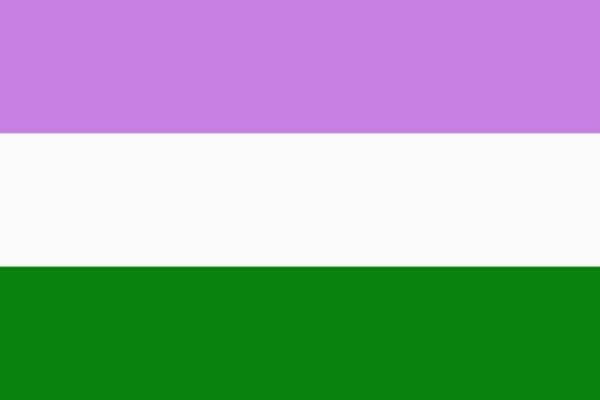
The Genderqueer Pride Flag, or genderqueer pride flag, is a symbol of identity and visibility for genderqueer people, that is, those who do not identify exclusively as male or female, but experience a gender identity that can be fluid, non-binary, or outside the binary gender system.
Flag features:
The genderqueer flag, created by Marilyn Roxie in 2011, consists of three horizontal stripes of equal size:
- Lavender: Represents androgyny, the combination of masculine and feminine.
- White: Represents agender identity, genderlessness.
- Chartreuse Green: Represents nonbinary identity, outside the male/female gender binary.
Meaning of the flag:
The Genderqueer Pride Flag symbolizes the diversity and complexity of the genderqueer experience. The colors represent the different shades of gender identity outside of binarism, embracing androgyny, agender, and non-binary identities.
The Genderqueer Pride Flag has helped raise the visibility of the genderqueer community by providing a symbol of identification and pride. It is used in rallies, Pride parades, and other events to celebrate genderqueer identity and promote acceptance.
Symbolism:
The genderqueer flag represents the struggle for recognition and acceptance of nonbinary gender identities, which are often invisibilized or marginalized. The flag challenges the binary view of gender, affirming that gender identity can be fluid, complex, and outside traditional categories.
Ally Pride Flag
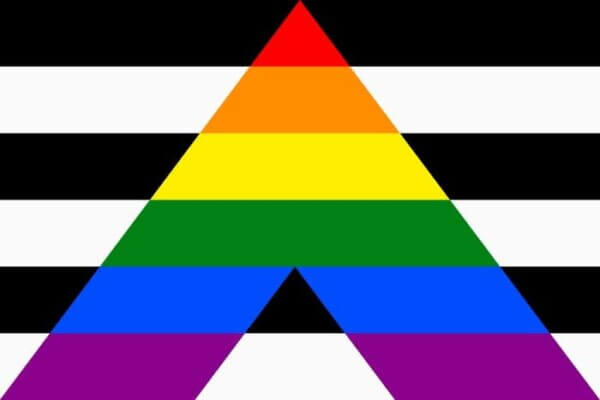
The Ally Pride Flag, or ally flag, is a symbol of support and solidarity for the LGBTQ+ community by non-LGBTQ+ people.
Flag features:
There are several versions of the Ally Pride Flag, but the most common one consists of:
- Inverted rain bow bands: To the left of the flag, the rainbow bands are arranged in reverse order of the traditional rainbow flag. This represents the idea that allies are “walking alongside” the LGBTQ+ community.
- Black stripe: The black stripe in the center of the flag represents the allies themselves, distinct from the LGBTQ+ community but still in solidarity with it.
- White stripe: The white stripe on the right represents heterosexual allies, emphasizing that support for the LGBTQ+ community can come from all sexual and gender identities.
Meaning of the flag:
The Ally Pride Flag represents allies’ commitment to support rights and equality for LGBTQ+ people. It is a symbol of solidarity, inclusion and a commitment to fight discrimination and prejudice.
The Ally Pride Flag has been adopted by many allies around the world as a symbol of their support for the LGBTQ+ community. It is often displayed at rallies, Pride parades, and other LGBTQ+ events to show solidarity and allyship.
Symbolism:
The allies flag represents the strength of alliance and the importance of coming together to fight oppression. It is a reminder that the fight for LGBTQ+ rights affects everyone, regardless of sexual orientation or gender identity.
Leather Pride Flag
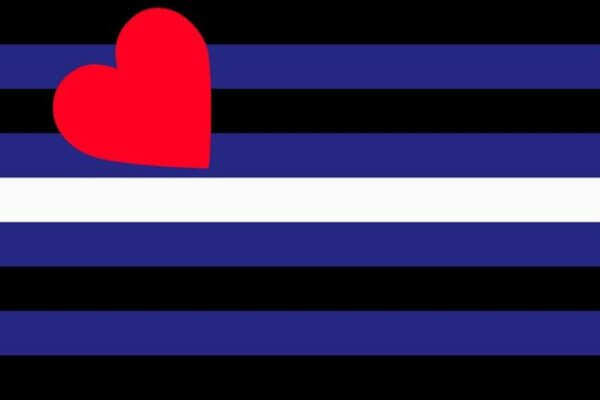
Although originally representative of members of the leather subculture, this banner has also been embraced by the broader BDSM and fetish community.
Designed by Tony DeBlase for the international celebration of Mr. Leather in Chicago in 1989 to mark the 20th anniversary of the Stonewall riots, the symbol represents people involved with sexual fantasies, including those who are heterosexual and/or cisgender.
The flag itself is open to interpretation, consisting of nine horizontal stripes of alternating black and blue colors, a white stripe in the center and a red heart in the upper left corner. DeBlase indicated that he wanted to ‘leave it up to the viewer to interpret the colors and symbols.’
Bear Brotherhood Pride Flag
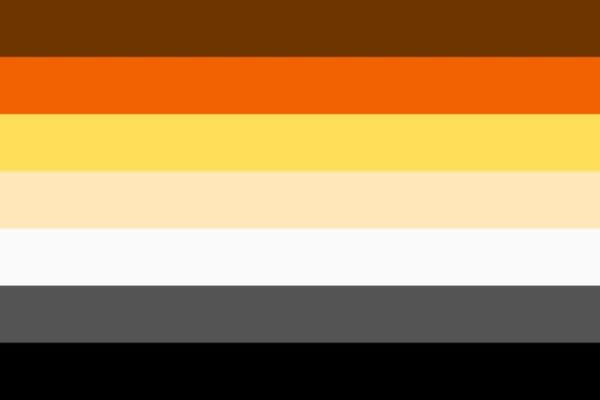
The Bear Brotherhood pride flag is an important symbol for the bear subculture within the LGBTQ+ community. Created in 1995 by Craig Byrnes and designed by Paul Witzkoske, it has become the official flag of the International Bear Brotherhood.
The flag features horizontal stripes of different colors:
- Dark brown: represents brown bears
- Light brown/orange: represents black bears
- Reddish brown: represents red bears
- Yellow: represents blond bears
- White: represents polar bears
- Black: represents all other bears, regardless of their fur color
The flag is a symbol of inclusion and diversity within the Bear community, welcoming people of all races, sizes and gender identities. It is often flown at Bear Pride events and other LGBTQ+ spaces to show pride and solidarity.
Polysexual Pride Flag
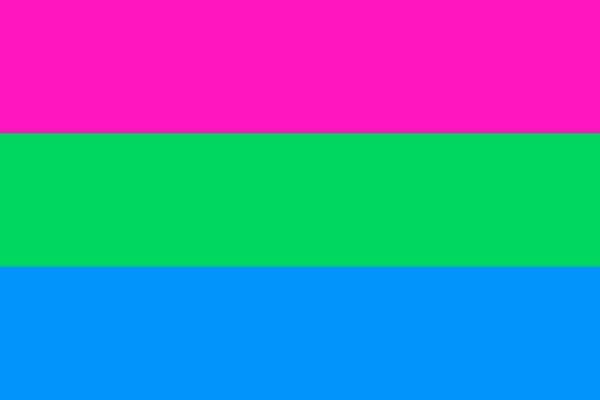
The polysexual pride flag is a symbol representing attraction to more than one gender, but not necessarily all genders. It was created in 2012 by a Tumblr user named Samlin in response to the lack of a specific flag for the polysexual community.
The flag consists of three horizontal stripes of color:
- Pink: represents attraction to women
- Green: represents attraction to people who do not identify in the male-female binary (nonbinary, genderfluid, etc.)
- Blue: represents attraction to men
The choice of colors is inspired by the bisexual and pansexual flags, replacing the purple and yellow stripes with green to indicate attraction to genders outside the traditional binary.
Aromantic Pride Flag
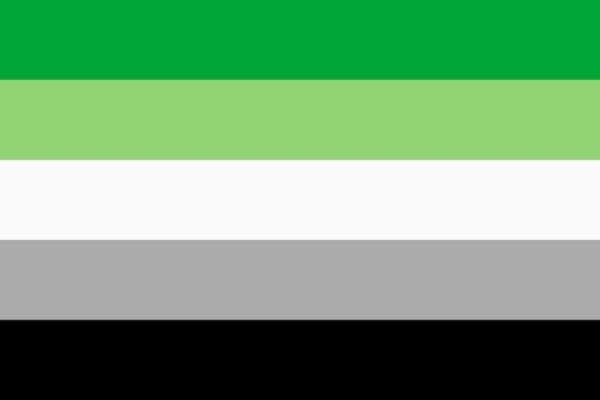
The Aromantic Pride flag is a symbol representing the experience of aromantic people, that is, those who feel little or no romantic interest in others. This flag was created in 2014 by a Tumblr user named Cameron Whimsy.
It is composed of five horizontal stripes of color:
- Dark green: Represents aromanticism in general. Green was chosen as the main color because it is the opposite of red, traditionally associated with romantic love.
- Light green: Represents the spectrum of aromanticism, recognizing that not all aromantic people experience it in the same way.
- White: Symbolizes platonic love and friendship, important aspects of the lives of aromantic people.
- Gray: Represents the demiromantic orientation, that is, those who experience romantic attraction only after establishing a strong emotional bond with the other person.
- Black: Represents the spectrum of sexuality, as aromanticism is not linked to a particular sexual orientation.
Lesvos flag
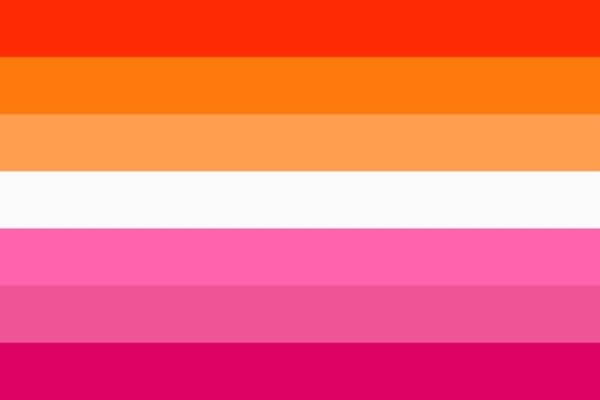
There are several flags representing lesbians within the LGBTQ+ community, and each has a particular history and meaning:
Lipstick Lesbian Flag: This flag, created in 2010, features seven horizontal stripes of red and pink, with a red kiss in the upper left corner. The colors represent different shades of lipstick, a traditional symbol of lesbian womanhood.
Lesbian Pride Flag: This flag, introduced in 2018, is a more modern and inclusive version of the Lipstick Lesbian flag. It features five horizontal stripes of orange and pink, representing:
- Dark orange: Gender nonconformity
- Light Orange: Independence
- White: Unique relationship with femininity
- Light pink: Serenity and peace
- Dark pink: Love and sex
Non-Binary Flag
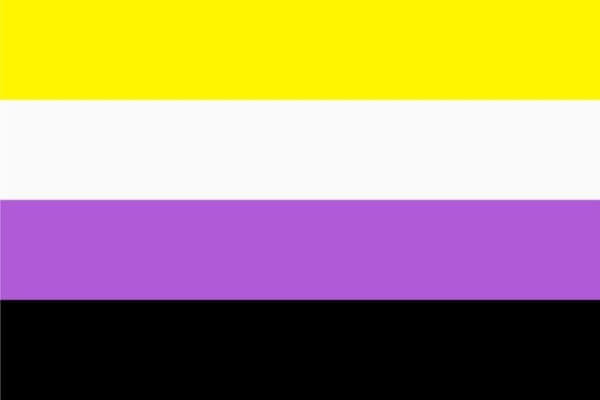
The nonbinary flag, also known as the genderqueer flag, is a symbol of pride and identification for nonbinary people-those who do not identify exclusively as men or women. Created in 2011 by Kye Rowan, the flag consists of four horizontal stripes of color:
- Yellow: It represents existence outside the male-female gender binary.
- White: Represents those who embrace many or all gender identities.
- Purple: Represents gender fluidity and those who identify as a combination of male and female genders.
- Black: Represents those who identify with no gender.
Pride of Africa Flag
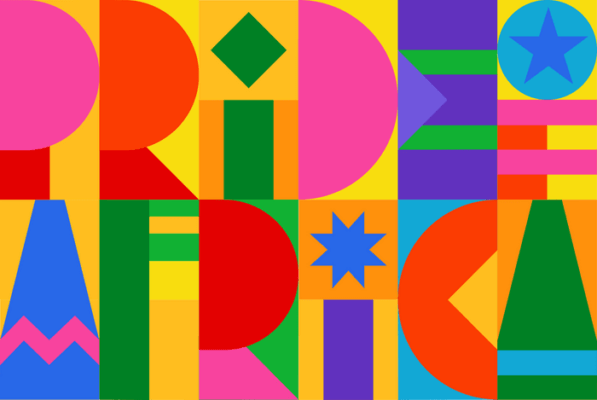
The Pride of Africa Flag was introduced in 2019 by Johannesburg Pride to represent the entire African LGBTQ+ community. It is a symbol of liberation, unity and acceptance for all members of the community, regardless of their country of origin.
Flag features:
- Design: It is inspired by the flags of all 54 African countries, combining elements and colors into a single visual representation.
- Meaning: Symbolizes the unity and diversity of Africa’s LGBTQ+ community, transcending national boundaries and discriminatory laws found in many countries.
- Message: The flag communicates a message of acceptance, welcome and safety for all members of the LGBTQ+ community in Africa.
Creation and use:
The flag was created by advertising agency Joe Public in collaboration with Johannesburg Pride. It was unveiled during the 2019 Johannesburg Pride and was enthusiastically received by the African LGBTQ+ community and its allies.
The flag has become an important symbol for Africa’s LGBTQ+ community, used at events and rallies across the continent to show pride and solidarity.
Queer People of Color Pride Flag
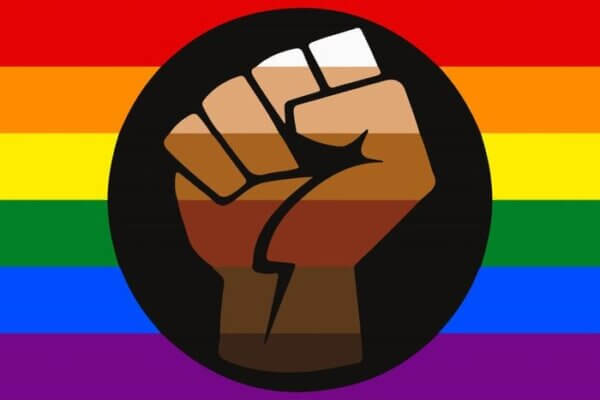
The Queer People of Color Pride Flag first emerged at San Francisco Pride in 2019, but gained greater visibility in 2020 during the Black Lives Matter protests.
Although the designer and original year are unknown, the flag represents how the struggle for racial equality and the struggle for queer equality often intersect. Queer people of color often face double discrimination, both because of their sexual orientation or gender identity and because of their race.
The flag is a variation of the traditional rainbow flag, with the addition of a black and brown arrow pointing to the right. The black and brown colors represent black and brown communities, while the arrow symbolizes forward movement and the struggle for social justice.
Intersex-Inclusive Pride Flag
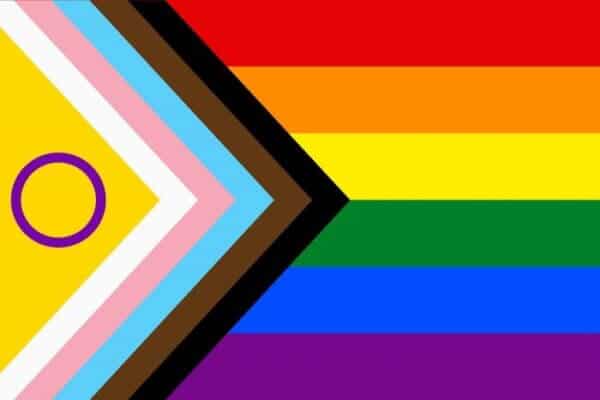
The Intersex-Inclusive Pride Flag is a modified version of the Progress Pride Flag, which itself is an evolution of the traditional rainbow flag.
The flag was created in 2021 by Valentino Vecchietti of Intersex Equality Rights UK as part of the campaign for visibility and inclusion of intersex people.
Flag features:
- Design: The flag maintains the six horizontal stripes of the original rainbow flag (red, orange, yellow, green, blue, purple) representing the diversity of the LGBTQ+ community.
- Additions: Includes a left triangle with light blue, pink, and white horizontal stripes to represent transgender and nonbinary people. It also incorporates black and brown stripes to represent people of color and marginalized communities.
- Intersex symbol: In the center of the triangle, there is a yellow circle with a purple ring, a symbol of intersex people. The circle represents wholeness and completeness, while purple is a color historically associated with intersex.
Trans-Inclusive Gay Men’s Pride Flag

The Trans-Inclusive Gay Men’s Pride Flag is a variation of the gay pride flag that includes a white stripe, taken from the transgender pride flag, to explicitly represent trans, nonbinary, gender nonconforming gay men. This inclusion is important because these individuals are often marginalized or excluded from mainstream representations of gay male identity.
The flag consists of five horizontal stripes:
- Green: It represents community and nature. Historically, gay men have used green flowers and plants (carnations, hyacinths, etc.) to symbolize their love.
- Aqua green: It represents healing.
- White: Represents transgender, nonbinary and gender nonconforming people.
- Indigo Blue: Represents diversity in presentations, relationships and life experiences.
- Purple: Represents strength and resilience.
Two-Spirit Pride Flag
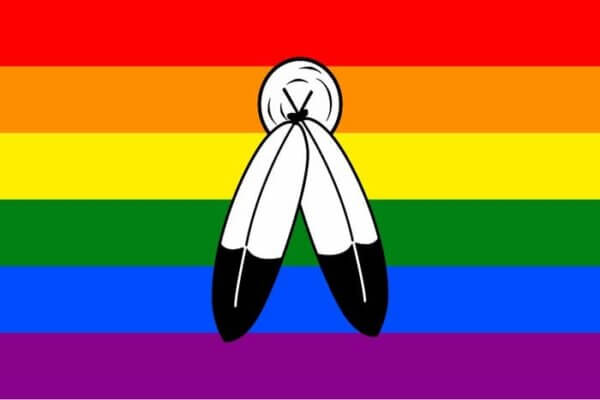
The Two-Spirit Pride Flag is an important symbol for indigenous people in North America who identify as “Two-Spirit,” a term that encompasses a wide range of gender and sexual identities other than binary male-female.
Flag features:
- Design: The flag features two feathers crossing each other, representing the two spiritual identities (male and female) present in an individual. The feathers are often surrounded by a circle, symbolizing the unity and interconnectedness of these two identities.
- Colors: Flag colors can vary, but often include shades of blue, pink, white and yellow. These colors may represent specific aspects of indigenous culture and spirituality.
- Variations: There are several variations of the flag, depending on the tribe or community to which it belongs. Some flags may include additional symbols, such as animals or natural elements, to represent specific cultural meanings.
Abrosexual Pride Flag
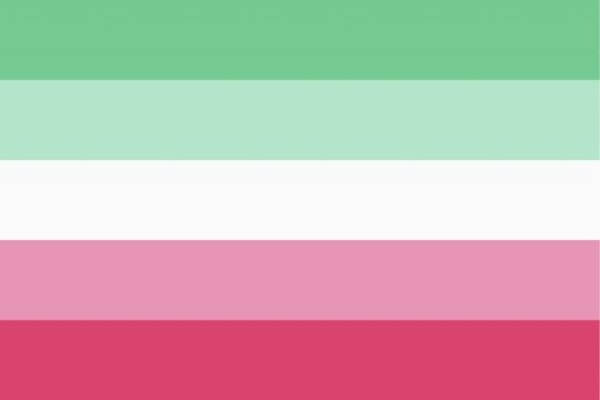
The Abrosexual Pride Flag is a symbol of abrosexual pride, a sexual orientation characterized by fluidity and change over time. Abrosexual people may experience attraction to different genders at different times in their lives.
The flag consists of five horizontal stripes:
- Dark green: Represents the beginning of a journey of sexual discovery.
- Light green: Represents exploration and openness to different attractions.
- White: Represents fluidity and changing sexual orientation.
- Light pink: Represents exploration and self-acceptance.
- Dark pink: Represents community and abrosexual love.
Although the original creator of the flag is unknown, it is believed to have been introduced in 2013 on Tumblr in response to a user’s request to have specific colors to represent abrosexuality.
Drag Pride Flag
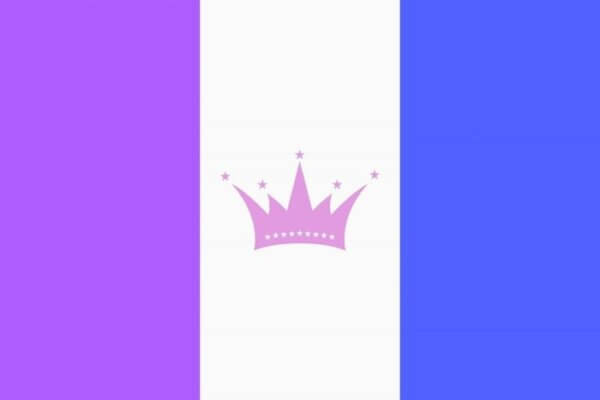
There are two main LGBTQ+ Drag flags:
Feather Pride Flag (1999):
- Creator: Sean Campbell
- Symbolism: The phoenix in the center represents the rebirth and passion of the drag community, particularly in supporting important causes.
- Meaning: Celebrates the resilience and creativity of drag culture.
Veranda L’Ni Flag (2016):
- Creator: Drag Queen Veranda L’Ni
- Design: Three vertical bands (purple, white, purple) with a crown and stars in the center.
- Symbolism:
- Viola: drag queen resistance
- White: Body and face used to create characters
- Crown and stars: royalty and talent of the drag community
Both flags represent:
- Pride: They celebrate drag culture as an art form and personal expression.
- Inclusiveness: They welcome all people involved in drag art, regardless of gender identity or sexual orientation.
- Resilience: They recognize the historical challenges faced by the drag community and its ability to resist and thrive.
Agender Pride Flag
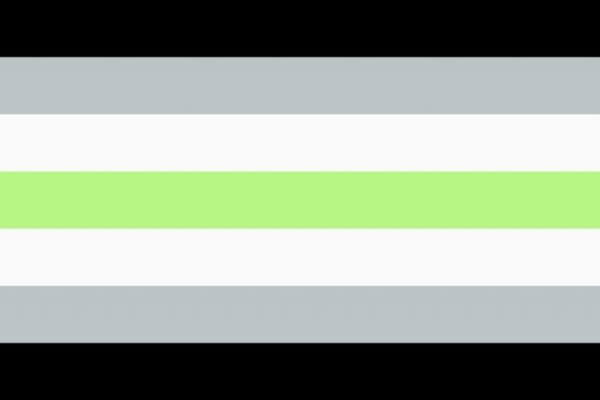
The Agender Pride Flag is an important symbol for people who identify as agender, that is, those who do not identify with any gender. This flag was created in 2014 by Salem X.
The flag consists of seven horizontal stripes:
- Black: represents genderlessness.
- Gray: represents being semi-agender or genderless.
- White: represents genderlessness.
- Green: represents nonbinary genders (as it is the inverse of purple, a color often associated with male-female gender mix).
- White: represents genderlessness.
- Gray: represents being semi-agender or genderless.
- Black: represents genderlessness.
Discover our Grindr tricks to optimize searches and find the right partner faster or discover our best LGBTQ+ guides for meeting services and gay clubs.
